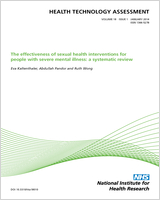Included under terms of UK Non-commercial Government License.
NCBI Bookshelf. A service of the National Library of Medicine, National Institutes of Health.
Clarke A, Pulikottil-Jacob R, Grove A, et al. Total hip replacement and surface replacement for the treatment of pain and disability resulting from end-stage arthritis of the hip (review of technology appraisal guidance 2 and 44): systematic review and economic evaluation. Southampton (UK): NIHR Journals Library; 2015 Jan. (Health Technology Assessment, No. 19.10.)

Total hip replacement and surface replacement for the treatment of pain and disability resulting from end-stage arthritis of the hip (review of technology appraisal guidance 2 and 44): systematic review and economic evaluation.
Show detailsOsteoarthritis (OA) is a leading cause of both pain and disability in the UK. People with OA can be treated with a total hip replacement (THR). This operation involves the replacement of a damaged hip joint with an artificial hip joint. Hip resurfacing arthroplasty (RS) (surgical repair of the joint) is a different operation. The hip joint is not removed but instead the joint surface of the leg bone (femur) is covered with a metal surface. The aim of this work was to review the clinical effectiveness and cost-effectiveness of both treatment options for patients who are suitable for either one. In addition, we aimed to review the different types of THR available.
Our review found that patients’ hip function and their general quality of life improved after having either operation. We found that more hip RS had to be revised than THR. The economic model showed that costs for RS were also higher than those for THR. Very similar results were found for all age and sex groups and THR was almost 100% cost-effective each time. When we investigated the differences between the different types of THR we found small but clear differences in the costs and effectiveness of particular types of THR for particular age and sex groups.
Overall, the review concluded that evidence about the benefits of THR and hip RS is lacking. We found that certain types of THR appeared to show some benefit over others. However, further research is needed and it should consist of better-quality studies that have longer follow-up of patients after their operations.
- Plain English summary - Total hip replacement and surface replacement for the tr...Plain English summary - Total hip replacement and surface replacement for the treatment of pain and disability resulting from end-stage arthritis of the hip (review of technology appraisal guidance 2 and 44): systematic review and economic evaluation
- Plant sample from Rubus corchorifoliusPlant sample from Rubus corchorifoliusbiosample
- List of supplementary material - Abrocitinib, tralokinumab and upadacitinib for ...List of supplementary material - Abrocitinib, tralokinumab and upadacitinib for treating moderate-to-severe atopic dermatitis
- Clinical effectiveness - Dasatinib, High-Dose Imatinib and Nilotinib for the Tre...Clinical effectiveness - Dasatinib, High-Dose Imatinib and Nilotinib for the Treatment of Imatinib-Resistant Chronic Myeloid Leukaemia: A Systematic Review and Economic Evaluation
- List of abbreviations - Diagnostic accuracy of the Thessaly test, standardised c...List of abbreviations - Diagnostic accuracy of the Thessaly test, standardised clinical history and other clinical examination tests (Apley’s, McMurray’s and joint line tenderness) for meniscal tears in comparison with magnetic resonance imaging diagnosis
Your browsing activity is empty.
Activity recording is turned off.
See more...